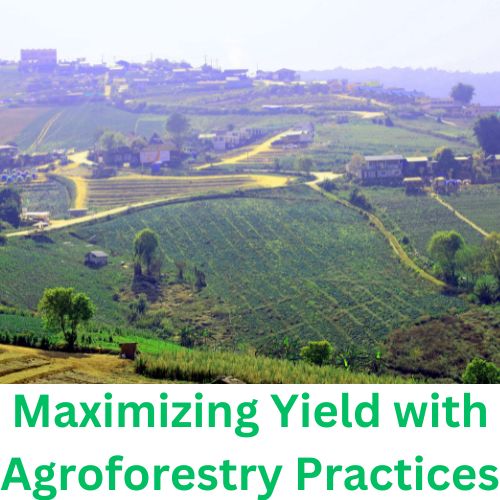Agroforestry, a sustainable land use management system that combines agriculture and forestry techniques, has gained recognition for its potential to increase agricultural productivity while promoting environmental conservation. In this essay, we explore the concept of “Fruits in the Forest” and how agroforestry practices can maximize fruit yield, offering a harmonious blend of food production and ecosystem preservation.
Understanding Agroforestry and Fruit Production
Agroforestry integrates trees, shrubs, or woody perennials with crops or livestock, creating a multi-dimensional and diversified farming system. When applied to fruit production, agroforestry becomes a powerful tool for increasing yield, enhancing ecological sustainability, and creating a synergy between nature and agriculture.
Chapter 1: The Orchard of Biodiversity
In the world of agroforestry, orchards that embrace biodiversity take center stage. These orchards promote the growth of fruit trees alongside a rich variety of other plants, fostering a thriving ecosystem that benefits both the environment and the farmer.
Innovative Story 1: The Diverse Orchards of Vietnam
In Vietnam, farmers have long practiced agroforestry with diverse orchards that include fruit trees like mangoes, lychees, and longans, among others. These orchards are interplanted with nitrogen-fixing legumes, herbs, and ground cover plants. The result is not only a bounty of fruits but also improved soil fertility and reduced pest pressure. The diverse orchards of Vietnam exemplify how agroforestry can transform mono-cropping landscapes into resilient and productive ecosystems.
Chapter 2: Fruitful Silvopasture: A Balance of Trees and Livestock
Silvopasture, a form of agroforestry that combines trees with livestock grazing, offers a unique opportunity to maximize fruit yield while maintaining sustainable animal husbandry.
Innovative Story 2: The Apple and Grazing Harmony in New Zealand
In New Zealand, apple orchards have incorporated grazing of sheep in the inter-rows between fruit trees. The sheep not only provide a secondary source of income but also help manage grass and weeds, reducing the need for herbicides. This integrated approach ensures that fruit production coexists harmoniously with livestock farming, highlighting the versatility and sustainability of agroforestry systems.
Chapter 3: The Tropical Eden: Agroforestry in Rainforests
Tropical rainforests are known for their incredible biodiversity and, in some cases, fruit-rich canopies. Agroforestry practices have found a way to replicate this natural abundance while preserving the existing rainforest ecosystems.
Innovative Story 3: The Cacao Forests of Costa Rica
Costa Rican farmers have embraced agroforestry by cultivating cacao trees in the shade of native rainforest trees. This approach not only produces high-quality cacao for chocolate but also preserves vital habitats for wildlife. The cacao forests of Costa Rica showcase how agroforestry can thrive in ecologically sensitive regions, providing a sustainable income source for farmers without compromising biodiversity.
Chapter 4: The Regenerative Fruit Gardens of Tomorrow
As agriculture faces the challenges of climate change and dwindling resources, regenerative agroforestry practices are gaining momentum.
Innovative Story 4: The Permaculture Fruit Gardens in Australia
In Australia, permaculture enthusiasts have developed regenerative fruit gardens that incorporate principles of agroforestry, such as companion planting and soil restoration. These gardens require minimal external inputs and can provide a diverse range of fruits throughout the year. The permaculture fruit gardens of Australia demonstrate how agroforestry can offer a regenerative and sustainable approach to fruit production.
Chapter 5: The Path Forward: Promoting Agroforestry for Fruit Production
The “Fruits in the Forest” concept has the potential to revolutionize fruit production and contribute to food security and environmental conservation. To ensure the continued growth of agroforestry in fruit production, several key strategies must be considered:
1. Knowledge and Training: Farmers need access to training and resources to adopt agroforestry practices effectively. Government agencies, NGOs, and agricultural institutions can play a crucial role in providing education and technical support.
2. Policy Support: Governments can incentivize agroforestry through policies that promote sustainable land use and provide financial support to farmers who adopt these practices.
3. Market Access: Creating markets for sustainably grown fruits from agroforestry systems is essential. Consumers can drive demand for these products, encouraging more farmers to embrace agroforestry.
4. Research and Development: Continued research into agroforestry techniques, including crop-tree interactions and best practices, is crucial to improving productivity and sustainability.
Conclusion
In conclusion, “Fruits in the Forest” is not just a concept; it represents a path towards a more sustainable and bountiful future in fruit production. Agroforestry practices offer a harmonious way to maximize fruit yield while promoting biodiversity, improving soil health, and mitigating climate change impacts. The innovative stories shared in this essay illustrate the diverse approaches and adaptability of agroforestry in different regions and climates.
To unlock the full potential of agroforestry in fruit production, it requires concerted efforts from farmers, policymakers, researchers, and consumers alike. By embracing these practices, we can create a world where fruitful harvests coexist with thriving ecosystems, ensuring the well-being of both humanity and the planet. The “Fruits in the Forest” narrative is one of hope, innovation, and sustainability, lighting the way towards a brighter agricultural future.
